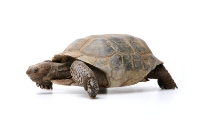Basic Care: Desert Tortoise

The desert tortoise is found throughout much of its range which includes both the Sonoran and Mojave deserts. Recently the desert tortoise was split into 2 separate species. The Agassiz's desert tortoise (Gopherus agassizi) lives in the Mojave deserts of California, Nevada, Utah, and Arizona west of the Colorado river. The Morofka's desert tortoise (Gopherus Morafkai) resides in the Sonoran deserts of Arizona east of the Colorado river and Mexico. The 2 species can interbreed and many of the captive tortoises in the Phoenix area are hybrids, which can only be determined by genetic testing.
Wild desert tortoise populations are threatened by development and destruction of natural habitat. In the meantime, captive tortoises have the opposite problem and have become over-populated. Large numbers of tortoises now sit homeless in sanctuaries throughout the southwest US. Wildlife officials are unable to return these captive to the wild because many are hybrids and there is a high risk of exposing wild tortoises to any diseases carried by these pet tortoises.
To know the current regulations, go online at www.azgfd.com or call a local Arizona Game and Fish Department office and ask for the latest regulations on amphibians and reptiles. Collecting a desert tortoise from the wild is illegal. Possession limit is one tortoise per person in a household.
Breeding desert tortoises presents a legal problem for some people. Breeding desert tortoises is illegal in Arizona.
Size: Up to 20 pounds
Lifespan: 60-100+ years
Captive Care Requirements:
Enclosure:
We recommend desert tortoises be housed outdoors whenever possible. Pens can be constructed with solid walls which the tortoises cannot see through. Tortoises will try in vain for hours to walk through fences if they can see through to the other side. The walls should extend below the ground surface a minimum of 6-12 inches to discourage tortoises from digging under the walls. The enclosure must also provide protection from predators and other family pets, such as dogs, which could harm the tortoise.
Indoor housing is only appropriate for small or sick members of this species. Young tortoises should be housed in enclosures with opaque sides for the same reason solid fencing is recommended for outdoor pens. Commercially available tortoise enclosures such as the Zoo Med Tortoise House or a terrestrial WaterLand Tub work well. However, a good sized storage container can work just as well.
Cage Size – Outdoor enclosures should be minimally 18 square feet in size for an adult tortoise.
Substrate – Natural soil (outdoors) or compacted organic topsoil are preferred. Alternatively a mix of cypress mulch and coconut fiber bedding can be used. Avoid reptile barks, wood shavings, sand, and gravel as these can be accidentally ingested and the dust they contain can cause respiratory irritation. Rabbit pellets have been used, but use caution as this substrate molds very easily. Substrates should be at least 3-5 inches deep or more to allow the tortoise to burrow.
Cage Furnishings – Shelter should be provided such as a hide or cave for indoor tortoises and an artificial burrow for outdoor tortoises. Click here to see a diagram on how to construct an artificial burrow.
If water is provided use a shallow, wide dish large enough that allows the tortoise to fully climb inside. Alternatively, water can be provided by flooding a small area of the pen or soaking your tortoise for 15-30 minutes in shallow warm water several times a week. It's preferable to not have water available at all times for this species. Sporadic water availability encourages them to drink well and empty their bladders fully.
Use a flat dish or patio stone for a food dish to prevent the tortoise from accidentally ingesting substrate while eating.
Temperature – Daytime: 85-88°F; Nighttime: 75-80°F; Basking 95-100°F. Provide heat indoors using a heat lamp. Place the lamp off to one side of the enclosure to allow for a temperature gradient. The use of a thermometer and thermostat is recommended to assure proper temperatures.
Lighting – When housed indoors desert tortoise should be provided artificial UVB lighting to allow for proper calcium absorption form their diet. This should be provided through a commercially available fluorescent or mercury vapor reptile bulb specifically designed for this purpose. Follow the manufacturer’s instructions as far as bulb placement, typically most bulbs require the animal to be able to get within 12-18” for proper UVB exposure. Bulbs should be replaced every 6-12 months, again depending on the manufacturer’s recommendations, as they will stop producing UVB light long before they stop giving off visible light.
Tortoises housed outdoors will receive all the UVB light they need from the sun.
Click here to learn more about UVB lighting.
Disinfection and Cleaning – For indoor enclosures, droppings should be removed as noted but minimally daily. Substrates should be replaced 1-2 times monthly or more if needed. Disinfect the enclosure and furnishings at least monthly using a 1 to 10 freshly made dilute bleach solution. Make sure to rinse the enclosure well with water after to remove the bleach. Drying the enclosure in the sun will also help in the disinfection process.
Outdoor enclosures should be free of visible feces which should be raked up regularly. Water bowls should be cleaned and sanitized every 2-4 weeks as above.
Diet
Desert tortoises are herbivores, meaning they eat plants. They require diets high in fiber for healthy growth and digestion. The majority of their diet should be grasses and weeds. The easiest way to provide this is to provide the tortoise with access to grassy areas where they can graze. Alternatively, grass hay can be provided, such as Timothy, Bermuda, or orchard grass hays. Edible shrubs and garden plants can also be planted in the enclosure, which many tortoises will relish. Weeds and native shrubs are especially important to growing, juvenile tortoises. Planting Dichondra along with their grass is an easy way to achieve this in outdoor habitats A list of native plants for desert tortoises is available here and a list of all edible plants is available by clicking here. Diets can be supplemented with leafy greens, fruits, edible flowers and vegetables, but it’s important to limit these items to no more than once weekly as these tortoises are adapted to grazing grasses. Mazuri LS Tortoise Pellets can be given no more than weekly. Desert tortoises do not do as well on other brands of pellets and we recommend avoiding pellets with artificial colors.
Never feed your desert tortoise meat, insects, dog or cat foods, or monkey biscuits. These high protein foods will lead to shell abnormalities and kidney disease.
It is important to limit access to water. Instead of providing a water bowl we recommend soaking the tortoise in shallow warm water for 15-30 minutes 1-2 times weekly. This will encourage them to drink and to fully void their bladder, which will help prevent bladder stones.
Dietary Supplementation – Desert tortoises housed indoors or young, rapidly growing tortoises should have their diet supplemented with a calcium carbonate powder such as ReptiCal 2-3 times weekly. More information on nutritional supplementation is available here.
Hibernation
This species of tortoise hibernates in colder, winter months. For more information on how to hibernate your tortoise click here.



